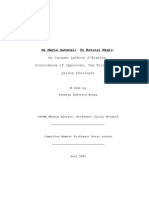Digital Image Processing Unit-3
Uploaded by
Pritesh GuptaDigital Image Processing Unit-3
Uploaded by
Pritesh Guptawww.jntuworld.
com
LCE/7.5.1/RC 01
TEACHING NOTES
Department: ELECTRONICS & COMMUNICATION ENGINEERING Unit: III Date: Topic name: Image Enhancement Point Processing No. of marks allotted by JNTUK: Books referred: 01. Digital Image Processing by R C Gonzalez and R E Woods 02. www.wikipedia.org 03. www.google.com Image Enhancement: The aim of image enhancement is to improve the interpretability or perception of information in images for human viewers, or to provide better input for other automated image processing techniques. Image enhancement techniques can be divided into two broad categories: 1. Spatial domain methods, which operate directly on pixels, and 2. Frequency domain methods, s, which operate on the Fourier transform of an image. Unfortunately, there is no general theory for determining what `good image enhancement is when it comes to human perception. If it looks good, it is good! However, when image enhancement techniques are used as pre-processing pre processing tools for other image processing techniques, then quantitative measures can determine which techniques are most appropriate. Spatial Domain Methods: The value of a pixel with coordinates (x, y) in the enhanced image F is the res result of performing some operation on the pixels in the neighborhood of (x, y) in the input image, F. Neighborhoods can be any shape, but usually they are rectangular. Grey scale manipulation: The simplest form of operation is when the operator T acts only on a 11 pixel neighborhood in the input image that is F (x, y) depends on the value of F only at (x, y). This is a grey scale transformation or mapping. The simplest case is threshold where the intensity profile is replaced by a step function, active at a chosen threshold value. In this case any pixel with a grey level below the threshold in the input image gets mapped to 0 in the output image. Other pixels are mapped to 255. Other grey scale e transformations are outlined in figure figure-1 below.
a F
D a
O o
n E
e n i g
s r e
m o .c
Faculty/Date: Page 1 of 4
HOD/Date:
www.jntuworld.com
LCE/7.5.1/RC 01
TEACHING NOTES
Department: ELECTRONICS & COMMUNICATION ENGINEERING Unit: III Date: Topic name: Histogram Processing No. of marks allotted by JNTUK: Books referred: 01. Digital Image Processing by R C Gonzalez and R E Woods 02. www.wikipedia.org 03. www.google.com Histogram Processing: Histogram equalization is a common technique for enhancing the appearance of images. Suppose we have an image which is predominantly dark. Then its histogram would be skewed towards the lower end of the grey scale and all the image detail is compressed into the dark end of the histogram. If we could stretch out the grey levels at the dark end to produce a more uniformly distributed histogram then the image would become much cleaner. Histogram equalization involves finding a grey scale transformation function that creates an output image with a uniform histogram. Q. How do we determine this grey scale transformation function? Assume our grey levels are continuous and have been normalized to lie between 0 and 1. We must find a transformation T that maps grey values r in the input image F to grey values s = T(r) in the transformed image F. It is assumed that, T is single valued & monotonically increasing, and 0 T(r) 1 for 0 r 1. The inverse transformation from s to r is given by, r = T-1(s). If one takes the histogram for the input image and normalizes it so that the area under the histogram is 1, we have a probability distribution for grey levels in the input image Pr(r). Q. If we transform the input image to get s = T(r) what is the probability distribution Ps(s)? From probability theory it turns out that Ps(S) = Pr(r)[dr/ds] Where, r = T-1(s). Consider the transformation,
a F
D a
O o
n E
e n i g
s r e
m o .c
s = T(r) = Pr()d
This is the cumulative distribution function of r. using this definition of T we see that the derivative of s with respect to r is ds/dr = Pr(r) Substituting this back into the expression for Ps, we get Ps(S) = Pr(r)[1/Pr(r)] = 1 for all s, where 0 s 1. Thus, Ps(s) is now a uniform distribution function, which is what we want. Faculty/Date: Page 2 of 4 HOD/Date:
www.jntuworld.com
LCE/7.5.1/RC 01
TEACHING NOTES
Department: ELECTRONICS & COMMUNICATION ENGINEERING Unit: III Date: Topic name: Spatial Filtering - 1 No. of marks allotted by JNTUK: Books referred: 01. Digital Image Processing by R C Gonzalez and R E Woods 02. www.wikipedia.org 03. www.google.com Spatial Filtering: A spatial filter is an optical device which uses the principles of Fourier optics to alter the structure of a beam of coherent light or other electromagnetic radiation. Spatial filtering is commonly used to clean up the output of lasers, removing aberrations in the beam due to imperfect, dirty, or damaged optics, or due to variations in the laser gain medium itself. This can be used to produce a laser beam containing only a single transverse mode of the lasers optical resonator. In spatial filtering, a lens is used to focus the beam. Because of diffraction, a beam that is not a perfect plane wave will not focus to a single spot, but rather will produce a pattern of light and dark regions in the focal plane. For example, an imperfect beam might form a bright spot surrounded by a series of concentric rings. It can be shown as follows:
a F
It can be shown that this 2D pattern is the 2DFT of the initial beams transverse intensity distribution. In this context, the focal plane is often called the transform plane. Light in the very center of the transform pattern corresponds to a perfect, wide plane wave. Other light corresponds to structure in the beam, with light further from the central spot corresponding to structure with higher spatial frequency. A pattern with very fine details will produce light very far from the transform planes central spot. In the example above, the large central spot and rings of light surrounding it are due to the structure resulting when the beam passed through a circular aperture. The spot is enlarged because the beam is limited by the aperture to a finite size, and the rings relate to passed through a circular aperture. The spot is enlarged because the beam is limited by the aperture to a finite size, and the rings relate to the sharp edges of the beam created by the edges of the aperture. This pattern is called an Airy pattern, after its discoverer George Airy. In practice, the diameter of the aperture is chosen based on the focal length of the lens, the diameter and quality of the input beam, and its wavelength. If the hole is too small, the beam quality is greatly improved but the power is greatly reduced. If the hole is too large, the beam quality may not be improved as much as desired. The size of aperture that can be used also depends on the size and quality of the optics. To use a very small pinhole, one must use a focusing lens with a low f-number, and ideally the lens should not add significant aberrations to the beam. The design of such a lens becomes increasingly more difficult as the f-number decreases.
D a
O o
n E
e n i g
s r e
m o .c
Faculty/Date: Page 3 of 4
HOD/Date:
www.jntuworld.com
LCE/7.5.1/RC 01
TEACHING NOTES
Department: ELECTRONICS & COMMUNICATION ENGINEERING Unit: III Date: Topic name: Spatial Filtering - 2 No. of marks allotted by JNTUK: Books referred: 01. Digital Image Processing by R C Gonzalez and R E Woods 02. www.wikipedia.org 03. www.google.com In practice, the most commonly used configuration is to use a microscope objective lens for focusing the beam, and an aperture made by punching a small, precise, hole in a piece of thick metal foil. Such assemblies are available commercially.
a F
D a
O o
n E
e n i g
s r e
m o .c
Faculty/Date:
HOD/Date:
Page 4 of 4
You might also like
- A Comprehensive Study of Digital Photo Image Enhancement TechniquesNo ratings yetA Comprehensive Study of Digital Photo Image Enhancement Techniques9 pages
- Digital Image Processing: Image Enhancement in The Spatial DomainNo ratings yetDigital Image Processing: Image Enhancement in The Spatial Domain139 pages
- Digital Image Processing IMAGE ENHANCEMENTNo ratings yetDigital Image Processing IMAGE ENHANCEMENT35 pages
- Area Overview 1.1 Introduction To Image ProcessingNo ratings yetArea Overview 1.1 Introduction To Image Processing41 pages
- Image Enhancement in Spatial Domain: Pixel Operations and Histogram ProcessingNo ratings yetImage Enhancement in Spatial Domain: Pixel Operations and Histogram Processing59 pages
- DIP Unit 2 (Enhancement, Binary, Colour)No ratings yetDIP Unit 2 (Enhancement, Binary, Colour)126 pages
- Image Transformation and Filtering: Priyanka PH.D Cse Uiet, PuNo ratings yetImage Transformation and Filtering: Priyanka PH.D Cse Uiet, Pu49 pages
- Image Enhancement: Computer Vision CITS4240No ratings yetImage Enhancement: Computer Vision CITS424012 pages
- What Is Digital Image? Intensity Gray LevelNo ratings yetWhat Is Digital Image? Intensity Gray Level19 pages
- Bio-Medical Image Enhancement Based On Spatial Domain TechniqueNo ratings yetBio-Medical Image Enhancement Based On Spatial Domain Technique5 pages
- Implementation of Image Enhancement and Segmentation TechniquesNo ratings yetImplementation of Image Enhancement and Segmentation Techniques8 pages
- Ch2-Image Enhancement in Spacial DomainNo ratings yetCh2-Image Enhancement in Spacial Domain117 pages
- Analysis of Image Restoration TechniquesNo ratings yetAnalysis of Image Restoration Techniques34 pages
- Digital Image Processing 03 Image Enhancement in Spatial DomainNo ratings yetDigital Image Processing 03 Image Enhancement in Spatial Domain57 pages
- Digital Image Processing: Image Enhancement in Spatial DomainNo ratings yetDigital Image Processing: Image Enhancement in Spatial Domain26 pages
- Radiosity Computer Graphics: Advancing Visualization through Radiosity in Computer VisionFrom EverandRadiosity Computer Graphics: Advancing Visualization through Radiosity in Computer VisionNo ratings yet
- Setting Up A MATLAB TCPIP Server SessionNo ratings yetSetting Up A MATLAB TCPIP Server Session5 pages
- An EPFL Student Has Developed A Video Analysis Algorithm Able To Estimate The Level of A DriverNo ratings yetAn EPFL Student Has Developed A Video Analysis Algorithm Able To Estimate The Level of A Driver3 pages
- CTS Placement Papers - CTS Cognizant Technology Solutions Placement Paper (Aptitude) (ID-3339)No ratings yetCTS Placement Papers - CTS Cognizant Technology Solutions Placement Paper (Aptitude) (ID-3339)3 pages
- Community Conversations Immigration ToolkitNo ratings yetCommunity Conversations Immigration Toolkit10 pages
- A Guide To Learning Japanese - Grammar & TestsNo ratings yetA Guide To Learning Japanese - Grammar & Tests37 pages
- De Magia Naturali, On Natural Magic, by Jacques Lefevre D'etaples: Coincidence of Opposites, The Trinity, and Prisca Theologia100% (1)De Magia Naturali, On Natural Magic, by Jacques Lefevre D'etaples: Coincidence of Opposites, The Trinity, and Prisca Theologia185 pages
- Role of Courts in Upholding Rule of Law - Hon'Ble Mr. Justice F.M. Ibrahim KalifullaNo ratings yetRole of Courts in Upholding Rule of Law - Hon'Ble Mr. Justice F.M. Ibrahim Kalifulla27 pages
- B - 20121023 - NGO Handbook - English - 150 PDFNo ratings yetB - 20121023 - NGO Handbook - English - 150 PDF80 pages
- A Mind For Numbers - Barbara Oakley - Memorization Booklet90% (10)A Mind For Numbers - Barbara Oakley - Memorization Booklet26 pages
- Philosophy of History and Theory of History-WhoNeedsThemNo ratings yetPhilosophy of History and Theory of History-WhoNeedsThem20 pages
- Essential Bibliography For English Language Teaching and Applied Linguistics PDFNo ratings yetEssential Bibliography For English Language Teaching and Applied Linguistics PDF149 pages
- A Comprehensive Study of Digital Photo Image Enhancement TechniquesA Comprehensive Study of Digital Photo Image Enhancement Techniques
- Digital Image Processing: Image Enhancement in The Spatial DomainDigital Image Processing: Image Enhancement in The Spatial Domain
- Area Overview 1.1 Introduction To Image ProcessingArea Overview 1.1 Introduction To Image Processing
- Image Enhancement in Spatial Domain: Pixel Operations and Histogram ProcessingImage Enhancement in Spatial Domain: Pixel Operations and Histogram Processing
- Image Transformation and Filtering: Priyanka PH.D Cse Uiet, PuImage Transformation and Filtering: Priyanka PH.D Cse Uiet, Pu
- Bio-Medical Image Enhancement Based On Spatial Domain TechniqueBio-Medical Image Enhancement Based On Spatial Domain Technique
- Implementation of Image Enhancement and Segmentation TechniquesImplementation of Image Enhancement and Segmentation Techniques
- Digital Image Processing 03 Image Enhancement in Spatial DomainDigital Image Processing 03 Image Enhancement in Spatial Domain
- Digital Image Processing: Image Enhancement in Spatial DomainDigital Image Processing: Image Enhancement in Spatial Domain
- Radiosity Computer Graphics: Advancing Visualization through Radiosity in Computer VisionFrom EverandRadiosity Computer Graphics: Advancing Visualization through Radiosity in Computer Vision
- From Photon to Pixel: The Digital Camera HandbookFrom EverandFrom Photon to Pixel: The Digital Camera Handbook
- Digital Image Processing: Fundamentals and ApplicationsFrom EverandDigital Image Processing: Fundamentals and Applications
- An EPFL Student Has Developed A Video Analysis Algorithm Able To Estimate The Level of A DriverAn EPFL Student Has Developed A Video Analysis Algorithm Able To Estimate The Level of A Driver
- CTS Placement Papers - CTS Cognizant Technology Solutions Placement Paper (Aptitude) (ID-3339)CTS Placement Papers - CTS Cognizant Technology Solutions Placement Paper (Aptitude) (ID-3339)
- De Magia Naturali, On Natural Magic, by Jacques Lefevre D'etaples: Coincidence of Opposites, The Trinity, and Prisca TheologiaDe Magia Naturali, On Natural Magic, by Jacques Lefevre D'etaples: Coincidence of Opposites, The Trinity, and Prisca Theologia
- Role of Courts in Upholding Rule of Law - Hon'Ble Mr. Justice F.M. Ibrahim KalifullaRole of Courts in Upholding Rule of Law - Hon'Ble Mr. Justice F.M. Ibrahim Kalifulla
- A Mind For Numbers - Barbara Oakley - Memorization BookletA Mind For Numbers - Barbara Oakley - Memorization Booklet
- Philosophy of History and Theory of History-WhoNeedsThemPhilosophy of History and Theory of History-WhoNeedsThem
- Essential Bibliography For English Language Teaching and Applied Linguistics PDFEssential Bibliography For English Language Teaching and Applied Linguistics PDF

































































































